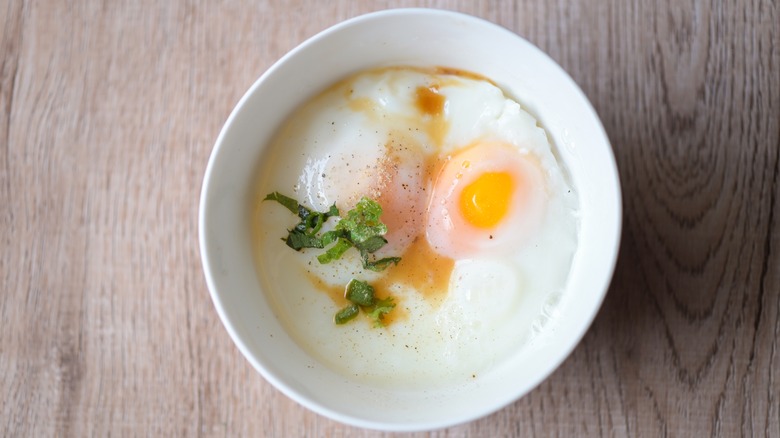The Piercing Step You Can't Forget When Microwaving Eggs
If you've ever been in a time crunch when making breakfast, you've probably considered just popping an egg or two into the microwave and hoping they cook. Perhaps surprisingly, you actually can microwave eggs. Although the texture might differ from what you get from cooking eggs in a frying pan, the eggs themselves will be fully cooked and perfectly safe to eat. But there is one important step to remember before microwaving an egg: to gently pierce the yolk and the egg white with a fork or a toothpick first. This will prevent the steam that will build up during the microwaving from causing the egg to explode.
Depending on how you prefer your eggs, you'll want to microwave them in increments to make sure they don't get overdone. The microwave isn't as easy to control as the stove because you can't watch the eggs every step of the way, so after piercing them, microwave them for about 30 seconds at a time and check them to make sure they don't get overcooked.
The argument for multiple piercings
When an egg is microwaved, the liquid in the egg creates steam that builds up while the egg cooks. That steam will get trapped inside the egg unless there is a way for it to escape. Steam might not seem dangerous, but it is just as hot as boiling water. If it gets trapped, it causes the egg to quickly rocket to a high internal temperature, which can cause the egg to explode in your microwave — ruining your breakfast and making a total mess.
Gently piercing the top layers of the yolk and white can help to avoid this catastrophe when microwaving eggs; just a couple of holes with the tip of a fork or toothpick are sufficient to create an avenue for the steam to escape, which helps you avoid spending 10 minutes cleaning eggs out of your microwave. Be careful to puncture only the top of the yolk; press too hard and you might rupture the yolk which could then leak out and cook through instead of remaining creamy.
More tips for cooking eggs in the microwave
The advice to pierce your eggs before cooking them in the microwave pertains to eggs that are cooked intact, such as poached, steamed, or over-easy. The most common and arguably easiest method is to microwave scrambled eggs. When you whisk the yolks with a little milk or water, you break them up, which means you won't have to worry about a build-up of steam creating any problems. You should microwave scrambled eggs in increments, taking them out and stirring them every 30 to 45 seconds to ensure they develop that desirable scrambled-egg curd, and that they're thoroughly cooked.
This might seem obvious, but make sure you're using a microwave-safe dish, and generously spray the dish with cooking spray or add a little butter before cooking in it, or else the eggs could be difficult to remove. And finally, don't cook the eggs on the highest power setting. Reduce it to about 50 to 70% power, which will prevent any part of the egg from cooking too quickly.


